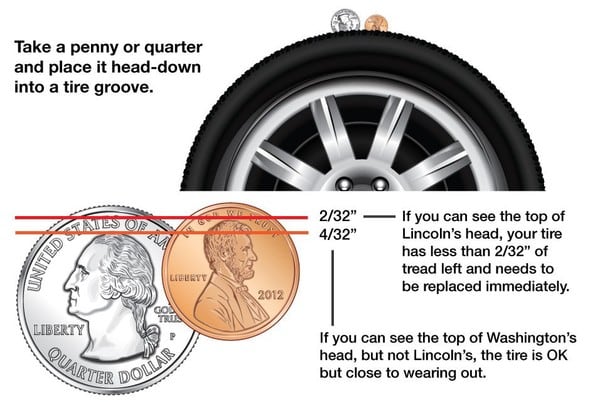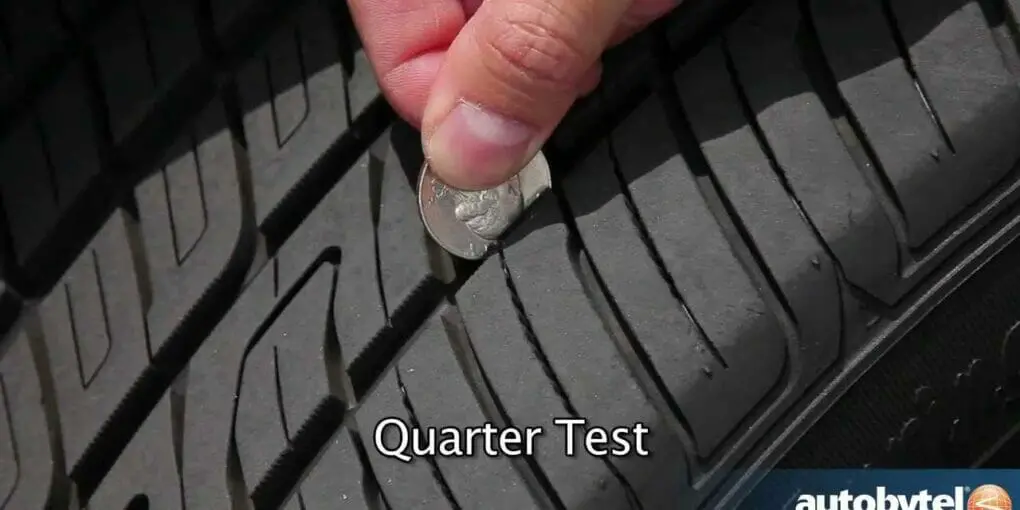How to Check Your Tires
It’s important to know how to check your tires. Not only will it save you money, but it could also save your life. Here are some tips on how to check your tires:
1. First, you’ll want to check the air pressure in all of your tires. You can do this with a tire gauge, which is relatively inexpensive and can be found at most auto parts stores. If the pressure in any of your tires is low, you’ll need to add air until it reaches the recommended level.
2. Next, you’ll want to take a look at the tread on your tires. This is important because it affects traction and can be dangerous if it gets too low. A simple way to check tread depth is by using a penny; if Abraham Lincoln’s head is visible when you insert the penny into the tread, that means the tread is shallow and needs to be replaced soon.
How to Check Your Tire Tread Depth with a Gauge or a Penny
- Park your car on a level surface and turn off the engine
- Locate the tire pressure gauge in your vehicle’s glove box, center console, or trunk
- Remove the cap from the valve stem on one of your tires
- Place the tip of the tire pressure gauge onto the valve stem and press down firmly to get an accurate reading
- Compare the reading on the tire pressure gauge to your vehicle’s recommended tire pressure levels
- If necessary, add air to your tires with a portable air compressor or at a gas station until you reach the recommended level
How to Check Tire Tread
If you want to be a safe driver, it is important to know how to check tire tread. Tires with little tread can be dangerous, especially in wet or icy conditions. There are a few different ways that you can check your tire tread depth.
One way is to use a penny. Insert the penny into the tread groove with Lincoln’s head upside down and facing you. If you can see all of Lincoln’s head, your tread depth is less than 2/32 inch and it is time to replace your tires.
Another way to check tread depth is to use a tread wear indicator bar. These bars are designed so that when they become level with the surrounding tread, it means the tire needs replaced. You can usually find these bars in several locations around the tire’s circumference.
Simply look for them while running your hand over the surface of the tire.If you don’t have access to a penny or a tread wear indicator bar, there is one final way you can measure your tire’s tread depth- by using a ruler or measuring tape. Place the ruler horizontally across the center of the tire at its widest point and measure from there down to the top of the tread grooves.
Each groove should be at least 1/16th of an inch deep in order for your tires to be considered safe. Anything less than that and it’s time for new tires!
How to Check Tires With a Penny
It’s important to regularly check your tires to ensure they are properly inflated and in good condition. Here’s a quick and easy way to check your tires with a penny.First, find a penny and insert it into the tread of your tire.
If you can see all of Abraham Lincoln’s head, then your tread is too worn down and you need new tires. If you can only see part of his head, then your tread is still okay but getting close to needing replacement.In addition to checking the tread, also make sure to check the air pressure in your tires at least once a month.
You can do this easily with a home air compressor or by taking your car to a gas station that has an air pump. Properly inflated tires will help improve gas mileage and extend the life of your tires!
Tire Inspection Cost
If you’re a driver, then you know that maintaining your vehicle is important. Part of that maintenance is making sure your tires are always in good condition. Tires can be expensive, so it’s important to know how much it will cost to have them inspected.
Generally, tire inspection costs will depend on the type of vehicle you have and the number of tires that need to be checked. For most passenger vehicles, expect to pay around $30 for a tire inspection. However, if you have a larger vehicle or more than four tires that need to be checked, the cost may be higher.
At a minimum, you should get your tires inspected once a year – preferably before winter hits. This way, you can make sure they’re properly inflated and don’t have any cracks or other damage that could cause problems down the road. If you wait too long to get your tires inspected, you may end up paying more in repairs or replacements later on.
So next time you’re due for a tune-up, don’t forget to add tire inspection to the list! It may not be the most exciting part of car maintenance, but it’s certainly one of the most important.
Tire Check near Me
If you’re looking for a tire check near you, there are a few things to keep in mind. First, make sure that the shop you choose is reputable and has experience with the type of vehicle you drive. Secondly, schedule an appointment in advance so that you don’t have to wait around for an available technician.
Lastly, be prepared to answer questions about your driving habits and vehicle maintenance history so that the technicians can properly assess your needs.
How to Check Tire Tread With a Gauge
Assuming you would like a blog titled “How to Check Tire Tread With a Gauge”:It is important to regularly check your tire tread in order to maintain optimal driving conditions and safety. You can check your tire tread with a gauge, which is a simple and easy process.
First, locate the tread wear indicator bars that are located in the deepest grooves of your tires. These bars are raised and flush with the rest of the tire when new, but as the tire wears down, these bars will become more pronounced.Next, take your gauge and place it in the groove of the tire next to the tread wear indicator bar.
The depth of the groove should be greater than or equal to 6/32” (4.8mm) in order for your tires to have enough tread left.If you find that any of your tires have less than 6/32” (4.8mm) of tread remaining, it is time to replace them. Be sure to consult your owner’s manual or local dealership for guidance on what type of replacement tires would be best for your vehicle make and model.

Credit: www.wowo.com
How Do You Check If Your Tires are Ok?
It is recommended that you check your tires at least once a month to ensure they are in good condition. There are a few things you can do to check if your tires are OK:1. Check the tread depth – The tread depth should be at least 4/32 of an inch.
You can use a tire tread depth gauge to measure this or simply insert a quarter into the tread groove. If the top of George Washington’s head is visible, then the tread depth is less than 4/32 of an inch and it’s time for new tires.
2. Look for signs of wear and tear – Check all four tires for evenly worn patterns.
Uneven wear could be a sign that something is wrong with your suspension or alignment. Also, look for cracks, bulges, or bald spots on the tires as these could cause blowouts.
3. Check the air pressure – Use a tire pressure gauge to check the air pressure in all four tires (including the spare).
The correct air pressure will be listed on either the driver’s door placard or inside fuel door flap. Don’t forget to check and adjust your tire pressure when it’s cold outside!
How Do I Check My Tires at Home?
It’s important to know how to check your tires at home, because it can help you avoid a blowout or other tire-related problems while on the road. Here’s what you need to do:1. Park your car on a level surface and turn off the engine.
2. Remove any hubcaps or wheel covers so you can see the entire tire.
3. Use a tire pressure gauge to check the air pressure in each tire. The recommended pressure will be listed on a sticker inside your driver’s side door, or in your owner’s manual.
4. If the pressure is low, use an air compressor or hand pump to add air until it reaches the recommended level.
5. Take a look at each tire to check for signs of wear and tear, such as cracks, bulges, or bald spots.
6. Use a lug wrench to loosen and remove any rocks or debris that may be lodged in the tread of your tires.
7. Finally, give each tire a quick spin to make sure they’re properly seated on the wheels before putting everything back together and hitting the road!
How Do You Tell If Tires Need Replace?
It is generally recommended that tires be replaced every six years, although this varies depending on the type of tire and driving habits. Many factors can affect how long tires last, including inflation levels, tread depth, weather conditions and driving habits.To check if your tires need to be replaced, start by looking at the tread depth.
Tires typically have tread wear indicator bars molded into the tread pattern which become visible when the tire’s remaining tread depth has reached 2/32nds of an inch. Once these bars are visible, it means the tire only has 2/32nds of an inch of tread left and needs to be replaced.In addition to checking the tread depth, also inspect your tires for any cracks or bulges in the sidewalls as these can indicate a structural issue that could lead to a blowout while driving.
If you notice any damage, replace the tire immediately.Finally, check your tires’ air pressure levels regularly using a gauge and inflate them to the recommended level listed in your car’s owner’s manual or on the placard inside your driver’s side doorjamb. Underinflated tires not only wear out faster but can also lead to decreased fuel efficiency and increased braking distances.
Conclusion
It’s important to check your tires regularly to ensure they are properly inflated and in good condition. Here’s how:First, find the right tire pressure for your car.
You can usually find this information on a sticker inside the driver’s door or in the owner’s manual.Next, use a tire pressure gauge to check the air pressure in each tire. If it’s low, add air until it reaches the correct level.
It’s also important to inspect your tires for signs of wear and tear. Look for cracks, bald spots, or anything else that doesn’t look normal. If you see any damage, it’s time to get new tires.


